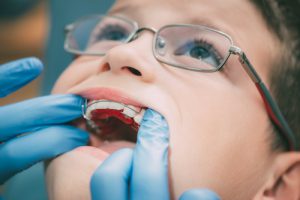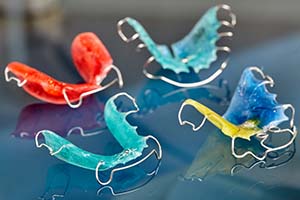Proper care of your braces and retainer is a pivotal part of making the most out of your orthodontic treatment. While simply wearing these appliances may seem sufficient enough to correct your dental flaws, developing easy hygiene habits that keep these appliances in clean, functional condition can have a vast impact on ensuring your treatment is as effective as possible. This is especially true in cases involving orthodontics for children, as teeth are still developing and require special care.
Failure to maintain the hygiene of your braces can lead to gum disease and plaque buildup, ultimately prolonging the length of your treatment. Fortunately, caring for your braces is much the same as a normal oral hygiene regimen and mostly consists of daily brushing and flossing. However, to keep the metal wiring, rubber bands, and springs in your mouth as plaque-free as possible, following the simple tips below from board-certified orthodontist Chris Murphy, DDS can help you remove food from the hard-to-reach areas around your braces.
How Do I Care for My Braces?
 Keeping braces in great condition involves two main steps: avoiding foods that can cause tooth decay, and thoroughly cleaning braces to prevent plaque buildup. A restricted diet may not sound ideal, but taking care now to limit plaque-attracting foods can save you time, money, and office visits in the future. Generally, orthodontic patients should limit foods that are sticky, hard, chewy, or easily caught within braces’ different metal components. These foods may include:
Keeping braces in great condition involves two main steps: avoiding foods that can cause tooth decay, and thoroughly cleaning braces to prevent plaque buildup. A restricted diet may not sound ideal, but taking care now to limit plaque-attracting foods can save you time, money, and office visits in the future. Generally, orthodontic patients should limit foods that are sticky, hard, chewy, or easily caught within braces’ different metal components. These foods may include:
- Caramel, taffy, gummy candy, gooey chocolate bars
- Gum, popcorn, or hard candies
- Sticky or chunky peanut butter
The foods listed above can break wiring and ultimately prolong the length of time required to straighten teeth. Food will naturally become caught in your braces; however, limiting foods that cause the most tooth decay can minimize the risk of orthodontic complications in the future.
How Do I Clean My Braces?
Braces can be a highly effective way to straighten teeth and correct jaw position, but they also easily attract plaque and decay if food particles are not brushed away. Fortunately, simple flossing and brushing is typically enough to clean stains from the surface of teeth and braces. For comprehensive flossing, patients can use a floss pick or waterpik to remove food between wiring. Brushing between braces with a proxabrush, or “Christmas tree” brush, can also easily reach food between brackets and rubber bands. Dr. Murphy usually recommends that teeth are brushed with a fluoride toothpaste after every meal.
How Do I Care for My Retainer?
 While many patients underestimate the importance of regularly wearing their retainer, the truth is that the retainer serves as the important final step of your orthodontic treatment. Retainers allow your jaw and teeth to remain in their newly aligned position and protect them from shifting. Neglecting to wear your removable retainer – especially in the first six months after braces are removed or Invisalign® treatment is complete – can cause your teeth to revert back to their old position and may even warrant further treatment.
While many patients underestimate the importance of regularly wearing their retainer, the truth is that the retainer serves as the important final step of your orthodontic treatment. Retainers allow your jaw and teeth to remain in their newly aligned position and protect them from shifting. Neglecting to wear your removable retainer – especially in the first six months after braces are removed or Invisalign® treatment is complete – can cause your teeth to revert back to their old position and may even warrant further treatment.
To keep your teeth in their desired position, retainers should be worn full-time for at least the first two to six months; however, this ultimately depends on each patient’s unique needs. Our orthodontic team will give you a clearer idea of how long it may be necessary to wear your retainer once that stage of the treatment process begins. If you believe a non-removable retainer fixed to your teeth would be most beneficial to you, you can inquire with Dr. Murphy about whether a fixed retainer would serve your needs. Otherwise, retainers should only be removed while eating, swimming, or engaging in certain recreational activities. After the first few months, Dr. Murphy can consult with you about a new treatment plan in which it may only be necessary to wear your retainer at night (depending on your specific orthodontic needs). To prevent a retainer from becoming brittle and breaking, it should also be cleaned daily and placed in its case when not in use.
How Do I Clean My Retainer?
 Neglecting to clean your retainer can make it weak and decrease its lifespan, but simply brushing your retainer daily can ensure it remains in durable condition. Brushing both sides of the retainer with a normal toothbrush and toothpaste is generally sufficient enough to remove bacteria; retainers should never be placed in cleaning solution or boiling water. If necessary you can further sanitize your retainer using denture cleaner or or a glass of water with baking soda. Additionally, try to avoid handling the retainer by its back edges, as this can cause breaks and cracks.
Neglecting to clean your retainer can make it weak and decrease its lifespan, but simply brushing your retainer daily can ensure it remains in durable condition. Brushing both sides of the retainer with a normal toothbrush and toothpaste is generally sufficient enough to remove bacteria; retainers should never be placed in cleaning solution or boiling water. If necessary you can further sanitize your retainer using denture cleaner or or a glass of water with baking soda. Additionally, try to avoid handling the retainer by its back edges, as this can cause breaks and cracks.
Taking simple steps to care for your braces and retainer can make all the difference in preserving your new smile for as long as possible. To learn more about proper orthodontic wear and care, or to schedule an initial consultation with Dr. Murphy, please contact our practice today.